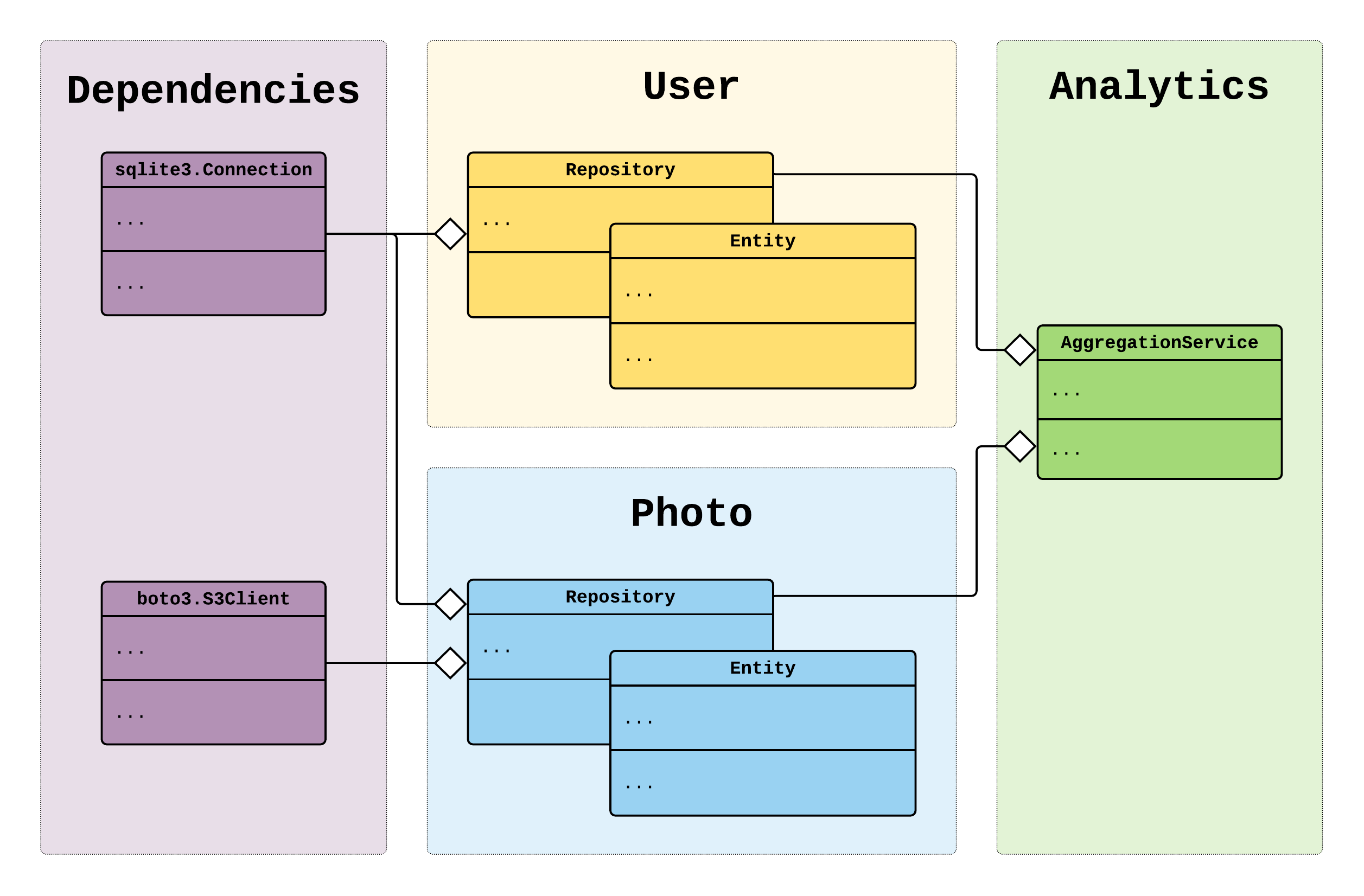Decoupled packages example (multiple containers)¶
This example shows how to use Dependency Injector to create decoupled packages.
To achieve a decoupling each package has a container with the components. When a component needs a
dependency from the outside of the package scope we use the Dependency provider. The package
container has no knowledge on where the dependencies come from. It states a need that the
dependencies must be provided. This helps to decouple a package from the 3rd party dependencies
and other packages.
To wire the packages we use an application container. Application container has all 3rd party dependencies and package containers. It wires the packages and dependencies to create a complete application.
We build an example micro application that consists of 3 packages:
user- a package with user domain logic, depends on a databasephoto- a package with photo domain logic, depends on a database and AWS S3analytics- a package with analytics domain logic, depends on theuserandphotopackage components

Start from the scratch or jump to the section:
You can find the source code and instructions for running on the Github.
Application structure¶
Application consists of an example package, a configuration file and a requirements.txt
file.
./
├── example/
│ ├── analytics/
│ │ ├── __init__.py
│ │ ├── containers.py
│ │ └── services.py
│ ├── photo/
│ │ ├── __init__.py
│ │ ├── containers.py
│ │ ├── entities.py
│ │ └── repositories.py
│ ├── user/
│ │ ├── __init__.py
│ │ ├── containers.py
│ │ ├── entities.py
│ │ └── repositories.py
│ ├── __init__.py
│ ├── __main__.py
│ └── containers.py
├── config.ini
└── requirements.txt
Package containers¶
Listing of the example/user/containers.py:
"""User containers module."""
from dependency_injector import containers, providers
from . import entities, repositories
class UserContainer(containers.DeclarativeContainer):
database = providers.Dependency()
user = providers.Factory(entities.User)
user_repository = providers.Singleton(
repositories.UserRepository,
entity_factory=user.provider,
db=database,
)
Listing of the example/photo/containers.py:
"""Photo containers module."""
from dependency_injector import containers, providers
from . import entities, repositories
class PhotoContainer(containers.DeclarativeContainer):
database = providers.Dependency()
file_storage = providers.Dependency()
photo = providers.Factory(entities.Photo)
photo_repository = providers.Singleton(
repositories.PhotoRepository,
entity_factory=photo.provider,
fs=file_storage,
db=database,
)
Listing of the example/analytics/containers.py:
"""Analytics containers module."""
from dependency_injector import containers, providers
from . import services
class AnalyticsContainer(containers.DeclarativeContainer):
user_repository = providers.Dependency()
photo_repository = providers.Dependency()
aggregation_service = providers.Singleton(
services.AggregationService,
user_repository=user_repository,
photo_repository=photo_repository,
)
Application container¶
Application container consists of all packages and 3rd party dependencies. Its role is to wire everything together in a complete application.
Listing of the example/containers.py:
"""Containers module."""
import sqlite3
import boto3
from dependency_injector import containers, providers
from .user.containers import UserContainer
from .photo.containers import PhotoContainer
from .analytics.containers import AnalyticsContainer
class ApplicationContainer(containers.DeclarativeContainer):
config = providers.Configuration(ini_files=["config.ini"])
sqlite = providers.Singleton(sqlite3.connect, config.database.dsn)
s3 = providers.Singleton(
boto3.client,
service_name="s3",
aws_access_key_id=config.aws.access_key_id,
aws_secret_access_key=config.aws.secret_access_key,
)
user_package = providers.Container(
UserContainer,
database=sqlite,
)
photo_package = providers.Container(
PhotoContainer,
database=sqlite,
file_storage=s3,
)
analytics_package = providers.Container(
AnalyticsContainer,
user_repository=user_package.user_repository,
photo_repository=photo_package.photo_repository,
)
Note
Package analytics has dependencies on the repositories from the user and
photo packages. This is an example of how you can pass the dependencies from one package
to another.
Main module¶
Listing of the example/__main__.py:
"""Main module."""
from dependency_injector.wiring import Provide, inject
from .user.repositories import UserRepository
from .photo.repositories import PhotoRepository
from .analytics.services import AggregationService
from .containers import ApplicationContainer
@inject
def main(
user_repository: UserRepository = Provide[
ApplicationContainer.user_package.user_repository
],
photo_repository: PhotoRepository = Provide[
ApplicationContainer.photo_package.photo_repository
],
aggregation_service: AggregationService = Provide[
ApplicationContainer.analytics_package.aggregation_service
],
) -> None:
user1 = user_repository.get(id=1)
user1_photos = photo_repository.get_photos(user1.id)
print(f"Retrieve user id={user1.id}, photos count={len(user1_photos)}")
user2 = user_repository.get(id=2)
user2_photos = photo_repository.get_photos(user2.id)
print(f"Retrieve user id={user2.id}, photos count={len(user2_photos)}")
assert aggregation_service.user_repository is user_repository
assert aggregation_service.photo_repository is photo_repository
print("Aggregate analytics from user and photo packages")
if __name__ == "__main__":
application = ApplicationContainer()
application.wire(modules=[__name__])
main()
Configuration¶
Listing of the config.ini:
[database]
dsn=:memory:
[aws]
access_key_id=KEY
secret_access_key=SECRET
Run the application¶
You can find the source code and instructions for running on the Github.
Sponsor the project on GitHub: |
